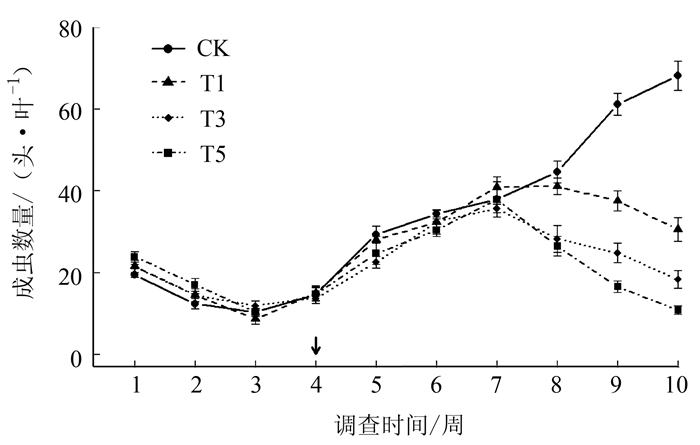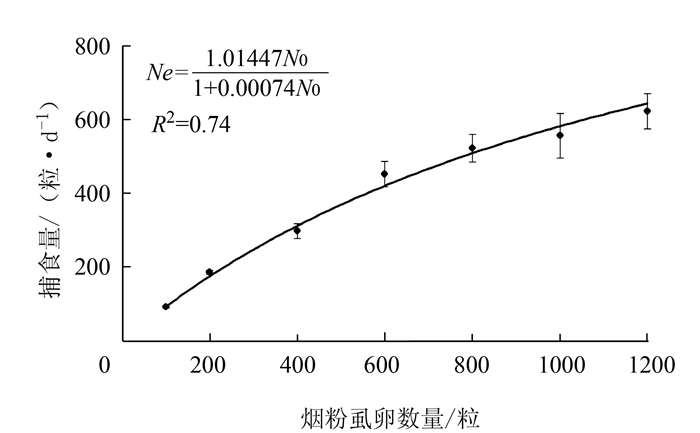Controlling Effect of Serangium japonicum on Population of Bemisia tabaci
-
摘要: 在实验室条件下测定了日本刀角瓢虫对烟粉虱的捕食作用和功能反应,并通过田间笼罩试验评价了日本刀角瓢虫对烟粉虱种群的控制作用。结果表明,日本刀角瓢虫成虫和各龄幼虫均可捕食烟粉虱各虫态,其中单头瓢虫雌成虫对烟粉虱卵、1~4龄若虫的日均捕食量分别为640.8粒和514.4、306.0、136.1、70.4头;单头瓢虫1~4龄幼虫对烟粉虱卵的日均捕食量分别为57.8、133.7、403.7、660.9粒;瓢虫雌成虫对烟粉虱卵的功能反应模型属HollingⅡ型,瞬间攻击率(α)为1.0144,处理猎物时间(Th)为0.000 7,单只雌虫每日最大捕食量(1/h)为1 366.78粒;在田间笼罩实验中,释放瓢虫后的第6周,与对照相比,每株释放1、3、5对瓢虫对烟粉虱成虫的控制效果分别达55.31%、73.25%和84.33%,对烟粉虱卵+若虫的控制效果分别达53.82%、83.14%和91.79%。Abstract: The predatory ability and functional response of Serangium japonicum on Bemisia tabaci (Homoptera:Aleyrodidae) were evaluated in the laboratory, and potential of the predator in controlling the pest was estimated with a semi-field cage experiment. The results showed that the adults and all-age instar larvae of S. japonicum could prey on B. tabaci of all life stages. The daily average numbers of the egg and the 1st to the 4th nymph of the pest consumed by a female adult S. japonicum were 640.8, 514.4, 306.0, 136.1 and 70.4, respectively. The average daily consumptions of a 1st to a 4th larva of S. japonicum on B. tabaci eggs were 57.8, 133.7, 403.7 and 660.9, respectively. The functional response of female adult S. japonicum on B. tabaci eggs was determined to be Holling Ⅱ type, while the attack rate (α), handling time per egg (Th) and maximum consumption per day (1/h) were calculated to be 1.0144, 0.0007 and 1366.78, respectively. Six weeks after releasing one, 3 and 5 pairs of S. japonicum per eggplant in the cage, the controlling efficacies were 55.31%, 73.25% and 84.33%, respectively, on adult pests, and, 53.82%, 83.14% and 91.79%, respectively, on immature B. tabaci (including eggs and nymphs), as compared to CK (no release of the predatory insects).
-
烟粉虱Bemisia tabaci是世界性的重要害虫,寄主广泛,可通过直接刺吸、分泌蜜露诱发煤烟病以及传播病毒等产生危害[1]。由于烟粉虱的防治过分依赖化学杀虫剂,导致烟粉虱对大部分杀虫剂产生了抗药性,增加了防治难度[2-5]。因此,有必要寻求一些相应的替代措施,以缓解烟粉虱抗药性的发展。
长期以来,烟粉虱的生物防治研究一直备受关注,利用虫生真菌、捕食性天敌、寄生性天敌的生物防治成为替代化学防治的最重要手段之一[6-11]。我国烟粉虱的天敌资源丰富,其中日本刀角瓢虫Serangium japonicum是烟粉虱的一种重要的本地捕食性天敌优势种,广泛分布在我国南方地区[12-13]。但关于日本刀角瓢虫对烟粉虱控制效应的研究仍较少见[14-15]。本研究在实验室条件和田间笼罩实验条件下,测定了日本刀角瓢虫对烟粉虱的捕食能力及其不同释放密度对烟粉虱种群的控制效果,以期了解日本刀角瓢虫田间释放对烟粉虱种群的控制潜能,为有效利用该天敌瓢虫进行烟粉虱的生物防治提供依据。
1. 材料与方法
1.1 供试昆虫
烟粉虱和日本刀角瓢虫均是田间采集并室内饲养的实验种群。
1.2 日本刀角瓢虫对烟粉虱的捕食量测定
日本刀角瓢虫雌成虫对烟粉虱不同虫态的捕食量:在室内盆栽的茄子叶上定量接入烟粉虱成虫,让其产卵24 h,然后剔除成虫,饲养不同虫态的烟粉虱。按烟粉虱不同的发育进度取带有卵、1~4龄若虫的叶片在解剖镜下计数后在培养皿中饲喂单头瓢虫,每皿投入饥饿24 h的瓢虫成虫1头,24 h后调查记录被捕食猎物数量,每个处理重复10次。
日本刀角瓢虫各虫态对烟粉虱卵的捕食量:测定在直径为110 mm的培养皿中进行,每皿烟粉虱卵800~1 000粒。每皿分别饲喂瓢虫单头雌雄成虫、1~4龄幼虫,24 h后检查各处理被捕食卵粒数,每个处理重复10次。
1.3 日本刀角瓢虫成虫对烟粉虱卵的功能反应测定
在直径为110 mm的培养皿中进行测定,烟粉虱卵密度设为每皿100、200、400、600、800、1 000、1 200粒卵。每皿投入饥饿24 h的刀角瓢虫雌成虫1头,后置于温度27℃、相对湿度65%和光照14:10(L:D)的培养箱内,24 h后检查各处理被捕食卵粒数,重复10次。统计捕食量并拟合功能反应曲线。
1.4 日本刀角瓢虫成虫对烟粉虱种群的控制效果
试验于盆栽茄子苗在田间笼罩(80 cm×80 cm×150 cm)条件下进行,每盆1株,每笼罩放3盆。每株茄子苗上接入烟粉虱成虫150对,接虫4周后释放瓢虫,释放密度设置4个处理,分别为不释放瓢虫(对照处理,CK)、每株1、3、5对瓢虫,每个处理重复3次。每周调查1次不同处理中烟粉虱的种群数量消长动态,每盆苗每次调查其中1株的第1片叶、第2株苗的第4片叶和第3株的第7片叶,每周轮换抽叶调查,剪叶前先调查每片叶背面烟粉虱成虫数量,然后在体视镜下检查每片剪叶上1 cm2卵+若虫(伪蛹视为四龄若虫)的数量,每片叶上随机检查3个1 cm2,并将所调查的同株3片叶片上烟粉虱成虫或卵+若虫的平均值作为该处理的观察值。共调查10周,并根据第10周的调查结果计算瓢虫不同释放密度对烟粉虱种群的控制效果。
控制效果/%=[(对照区种群数量-释放区种群数量) /对照区种群数量]×100%
1.5 数据处理
捕食功能反应采用HollingⅡ型圆盘方程[16]进行拟合,其方程式为:
Ne=α·T·N0/(1+α·Th·N0)
其中:Ne为被捕食的猎物数;N0为猎物密度;T为试验总用时(在本研究中T=1 d);α为瞬间攻击率;Th为处置时间。根据所拟合的捕食功能方程参数α和Th,计算瓢虫对烟粉虱卵的日最大捕食量。采用单因素方差分析的方法对捕食量数据进行分析,采用重复测量的方法对瓢虫对烟粉虱种群的控制效应进行分析,数据分析在R语言[17]软件上进行。
2. 结果与分析
2.1 日本刀角瓢虫对烟粉虱的捕食量
图 1显示,日本刀角瓢虫雌成虫对烟粉虱的卵和各龄若虫均表现出很强的捕食能力,其中对烟粉虱卵的捕食量最高,单雌日均捕食量可达640.8粒;对烟粉虱各龄若虫的捕食量由高到低依次为1龄若虫、2龄若虫、3龄若虫、4龄若虫日均捕食量分别为514.4、306.0、136.1、70.4头,瓢虫对烟粉虱卵和各龄若虫的捕食量之间差异显著(F4,45 =127.6,P < 0.001)。图 2显示,不同虫态日本刀角瓢虫对烟粉虱卵的捕食量差异显著(F5,54=130.8,P < 0.001),瓢虫雌雄成虫及高龄幼虫对烟粉虱卵具有较强的捕食能力,其中4龄幼虫的捕食量最高,单头日均捕食量可达660.9粒,1龄幼虫的捕食量最低,日均捕食量为57.8粒。
![]() 图 4 释放日本刀角瓢虫对烟粉虱成虫数量消长动态的影响注:T1为释放1对瓢虫,T3为释放3对瓢虫,T5为释放5对瓢虫;箭头指示处为瓢虫释放时间,即调查的第4周。图 5同。Figure 4. Effect of S. japonicum release on population of adult B. tabaci
图 4 释放日本刀角瓢虫对烟粉虱成虫数量消长动态的影响注:T1为释放1对瓢虫,T3为释放3对瓢虫,T5为释放5对瓢虫;箭头指示处为瓢虫释放时间,即调查的第4周。图 5同。Figure 4. Effect of S. japonicum release on population of adult B. tabaci2.2 日本刀角瓢虫成虫对烟粉虱卵的功能反应
图 3显示,日本刀角瓢虫雌成虫对烟粉虱卵的功能反应模型属HollingⅡ型。利用HollingⅡ型圆盘方程拟合试验数据,求得日本刀角瓢虫雌成虫对烟粉虱卵的功能反应参数,结果显示,日本刀角瓢虫雌成虫的瞬间攻击率(α)为1.014 4(95%置信限为0.964 4~1.064 4),处理猎物时间(Th)为0.000 7(95%置信限为0.000 6~0.000 9),最大日捕食量(1/h)为1366.78粒。
2.3 日本刀角瓢虫对烟粉虱种群的控制作用
图 4结果显示,释放瓢虫前4周,即总调查时间的第1~4周,各处理间烟粉虱成虫数量差异不显著(F3,8 =1.131,P=0.393);释放瓢虫3周后,各处理间烟粉虱成虫数量差异也不显著(F3,8 =2.104,P=0.178);每株释放3对和5对瓢虫处理的烟粉虱成虫数量在释放瓢虫后的第4~6周均显著低于对照处理,而每株释放1对瓢虫处理的烟粉虱成虫数量在释放瓢虫后第4周与对照处理差异不显著,释放后第5周才出现明显下降。释放瓢虫6周后,不同处理间烟粉虱成虫的数量差异显著(F3,8 =40.601,P < 0.001),释放瓢虫处理的烟粉虱成虫数量均显著少于对照处理(T1:CK:z=3.807,P < 0.001;T3:CK:z=3.976,P < 0.001;T5:CK:z=5.715,P < 0.001)。释放瓢虫后的第6周,每株释放1、3、5对瓢虫处理的烟粉虱成虫数量分别为30.44、18.22、10.67头·cm-2,均显著低于对照处理的烟粉虱成虫数量(68.11头·cm-2),控制效果分别达55.31%、73.25%和84.33%。
图 5显示,释放瓢虫前4周,即总调查时间的第1~4周,各处理间烟粉虱卵+若虫的数量差异不显著(F3,8 =0.976,P=0.451);释放瓢虫1周后,各处理间烟粉虱卵+若虫的数量差异也不显著(F3,8=2.335,P=0.150);释放瓢虫6周后,各处理间烟粉虱卵+若虫的数量差异显著(F3,8=549.693,P < 0.001),释放瓢虫处理的烟粉虱卵+若虫的数量显著少于对照处理(T1:CK:z=3.799,P < 0.001;T3:CK:z=9.704,P < 0.001;T5:CK:z=11.215,P < 0.001),释放3对瓢虫(z=3.448,P=0.003)和释放5对瓢虫(z=4.059,P < 0.001)处理的控制效果显著优于释放1对瓢虫处理,而释放3对瓢虫和释放5对瓢虫的处理间差异不显著(z=0.688,P=0.897)。每株释放3对和5对瓢虫处理的烟粉虱卵+若虫数量在释放瓢虫后的第2周开始下降,而每株释放1对瓢虫处理的烟粉虱卵+若虫数量在释放瓢虫后的第2周仍持续增长,并在释放瓢虫后的第4周达到高峰,此后开始下降,瓢虫的控制效果才逐步显现。在释放瓢虫后的第6周,每株释放1、3、5对瓢虫处理的烟粉虱卵+若虫数量分别为36.22、13.22、6.44头·cm-2,均显著低于对照处理的烟粉虱非成虫数量(78.43头·cm-2),控制效果分别达53.82%、83.14%和91.79%。
3. 讨论与结论
捕食量是测定捕食性天敌的捕食潜能的一个重要指标。本研究结果发现,日本刀角瓢虫各龄幼虫和成虫均可取食烟粉虱卵和若虫,而且表现出很强的捕食能力,尤其对烟粉虱卵的捕食量巨大。日本刀角瓢虫4龄幼虫和雌成虫对烟粉虱卵的日均捕食量分别高达660.9粒·头-1和640.8粒·雌-1,这与姚松林等[14]的研究结果基本一致,因此日本刀角瓢虫对烟粉虱具有较好的控制潜力,在生物防治上极具开发应用价值。
田间笼罩试验结果发现,在瓢虫释放后的初期,烟粉虱成虫和卵+若虫数量没有被有效控制,而是与对照处理一样在此后的1~4周仍然继续增长,其中每株释放1对瓢虫处理的成虫和卵+若虫数量均在释放后第4周达到高峰,随后才逐步表现出对烟粉虱种群良好的控制效果;每株释放3对和5对瓢虫处理的成虫数量在释放后第3周达到高峰,卵+若虫数量在释放后第1~2周达到高峰,随后逐步表现出对烟粉虱种群的控制效果,表明释放日本刀角瓢虫对烟粉虱种群数量控制存在滞后现象。究其原因主要是:在释放瓢虫后的初期,由于瓢虫可直接捕食烟粉虱卵和若虫,而且捕食能力很强,使其对烟粉虱卵+若虫数量的控制效应可以在较短的时间内体现出来。但是,前期接入的150对烟粉虱经过4周时间的繁殖已经建立了较高的种群密度,在瓢虫释放前的抽样调查中发现分布于茄子植株中下部叶片上的大量烟粉虱拟蛹正在陆续羽化,导致烟粉虱成虫种群数量在瓢虫释放后的前几周内仍然可以继续增长。释放后期对烟粉虱成虫数量的控制作用则与瓢虫定居后的持续捕食、成功繁殖和种群增长有密切关系,因为在释放瓢虫后的第2周开始陆续观察到瓢虫新孵育的卵和幼虫,而且随后几周瓢虫种群数量不断增加。在释放瓢虫后的第4周开始,烟粉虱成虫的数量受到明显抑制。10周时,释放瓢虫显著地控制了烟粉虱种群密度,每株释放3对和5对瓢虫对烟粉虱成虫种群的控制效果分别高达73.25%和84.33%。因此,在生物防治中天敌释放后能否成功定居、繁殖并建立种群,对释放天敌对目标害虫的控制效果和持续控制是至关重要的。
已有研究表明,日本刀角瓢虫成虫寿命长,在26℃下产卵前期为3~10 d,不同羽化日龄成虫所处的生殖状态差异明显(另文发表)。在本研究的田间笼罩试验中,所释放瓢虫成虫的生殖状态至关重要,它将直接影响瓢虫释放后的种群建立及对烟粉虱种群的持续控制效果。此外,烟粉虱的生长发育和种群繁殖与湿度条件密切相关[18],本研究过程中笼罩内较高的湿度条件也会对试验结果产生一定的影响。因此,日本刀角瓢虫对烟粉虱自然种群的控制效果有待进一步的验证。
-
图 4 释放日本刀角瓢虫对烟粉虱成虫数量消长动态的影响
注:T1为释放1对瓢虫,T3为释放3对瓢虫,T5为释放5对瓢虫;箭头指示处为瓢虫释放时间,即调查的第4周。图 5同。
Figure 4. Effect of S. japonicum release on population of adult B. tabaci
-
[1] DE BARRO P J, LIU S S, BOYKIN L M, et al.Bemisia tabaci:a statement of species status[J].Annual Review of Entomology, 2011, 56:1-19. DOI: 10.1146/annurev-ento-112408-085504
[2] 何玉仙, 翁启勇, 黄建, 等.烟粉虱田间种群的抗药性[J].应用生态学报, 2007, 18(7):1578-1582. http://med.wanfangdata.com.cn/Paper/Detail/PeriodicalPaper_yystxb200707028 [3] 郑宇, 赵建伟, 何玉仙, 等.福建省烟粉虱田间种群抗药性发展及其影响因素[J].应用生态学报, 2012, 23(1):271-277. http://www.oalib.com/paper/4377767 [4] WANG Z, YAN H, YANG Y, et al. Biotype and insecticide resistance status of the whitefly Bemisia tabaci from China[J].Pest Management Science, 2010:66(12):1360-1366. DOI: 10.1002/ps.v66:12
[5] YAO F L, ZHENG Y, HUANG X Y, et al.Dynamics of Bemisia tabaci biotypes and insecticide resistance in Fujian province in China during 2005-2014[J].Scientific Reports, 2017(7):40803.
[6] GERLING D, ALOMAR O, AMO J.Biological control of Bemisia tabaci using predators and parastoids[J].Crop Protection, 2001, 20(9):779-799. DOI: 10.1016/S0261-2194(01)00111-9
[7] FARIA M, WRAIGHT S P. Biological control of Bemisia tabaci with fungi[J].Crop Protection, 2001, 20(9):767-778. DOI: 10.1016/S0261-2194(01)00110-7
[8] 张艳璇, 林坚贞, 张公前.胡瓜钝绥螨控制大棚甜椒烟粉虱的研究[J].福建农业学报, 2011, 26(1):91-97. http://www.cnki.com.cn/Article/CJFDTOTAL-KCZS201203028.htm [9] 张艳璇, 张公前, 季洁, 等.胡瓜钝绥螨对日光大棚茄子上烟粉虱的控制作用[J].生物安全学报, 2011, 20(2):132-140. [10] 黄振, 任顺祥, 吴建辉.玫烟色拟青霉对烟粉虱种群的控制作用[J].华南农业大学学报, 2007, 28(2):24-28. DOI: 10.7671/j.issn.1001-411X.2007.02.007 [11] 黄振, 任顺祥, 姚松林.淡色斧瓢虫Axinoscymnus cardilobus对烟粉虱Bemisia tabaci种群的控制作用[J].生态学报, 2008, 28(7):3075-3081. [12] LI S J, XUE X, AHMED M Z, et al.Host plants and natural enemies of Bemisia tabaci (Hemiptera:Aleyrodidae) in China[J]. Insect Science, 2011, 18(1):101-120. DOI: 10.1111/ins.2011.18.issue-1
[13] WANG X M, REN S X, CHEN X S.A review of the genus Serangium Blackburn (Coleoptera, Coccinellidae) from China[J].Zoo Keys, 2011, 134:33-63.
[14] 姚松林, 任顺祥, 黄振.日本刀角瓢虫形态特征及生物学特性研究[J].昆虫天敌, 2004, 26(1):22-27. http://mall.cnki.net/magazine/Article/KCTD200401004.htm [15] YAO F L, ZHENG Y, ZHAO J W, et al.Lethal and sublethal effects of thiamethoxam on the whitefly predator Serangium japonicum (Coleoptera:Coccinellidae) through different exposure routes[J].Chemosphere, 2015, 128:49-55. DOI: 10.1016/j.chemosphere.2015.01.010
[16] HOLLING C S, Some characteristics of simple types of predation and parasitism[J].Canadian Entomology, 1959, 91(7):385-398. DOI: 10.4039/Ent91385-7
[17] R CORE TEAM. R: A language and environment for statistical computing[CP]. R Foundation for Statistical Computing, Vienna, Austria. 2017. URL https://www.R-project.org.
[18] 林克剑, 吴孔明, 魏洪义, 等.温度和湿度对B型烟粉虱发育、存活和生殖的影响[J].植物保护学报, 2004, 31(2):166-172. http://www.oalib.com/paper/4833613 -
期刊类型引用(3)
1. 梁伊菲,王春伟. 黄芪根腐病尖孢镰刀菌LAMP可视化快速检测方法的建立. 山西农业科学. 2023(04): 420-426 .  百度学术
百度学术
2. 汪琨,赵福运,徐云飞,袁小凤,赵伟春. 茄病镰刀菌单克隆抗体的制备及胶体金免疫层析试纸条的研发. 中国生物工程杂志. 2022(07): 54-61 .  百度学术
百度学术
3. 董金龙. 福建地区多肉植物主要病虫害发生和防治. 福建热作科技. 2022(04): 46-48 .  百度学术
百度学术
其他类型引用(1)





 下载:
下载:




